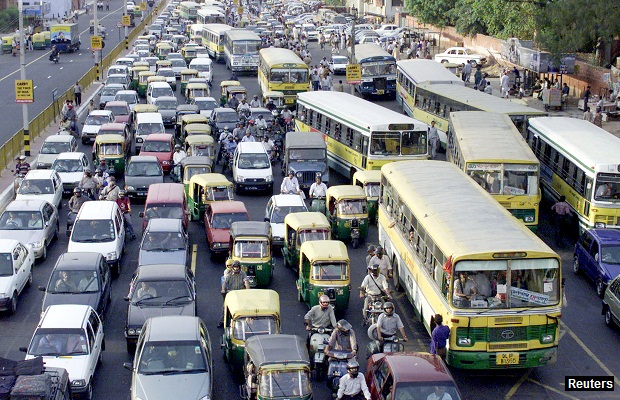Delhi's Declining Bus Use Points To Mass Transit Failures
Scrambling to find a solution to the world's worst urban air, Delhi's government has decided to add 6,000 buses to support the odd-even vehicle formula.
It will not be an easy task to convince Delhi-ites to take the bus.
Daily passenger ridership on Delhi Transport Corporation (DTC) buses declined 11% in 2014-15 over the previous year, and the number of buses has declined 24% over the past five years, from 6,204 in 2010-11 to 4,712 in 2014-15.
But vehicles per 1,000 people have increased 92% over the past 16 years, even as buses and their ridership declined, according to Delhi’s Economic Survey 2014-15.
Delhi's buses carry 3.9 million passengers every day, each bus covering an average of 7.8 km.
The Delhi metro, which has a network of 187 km across seven lines, now carries 2.4 million commuters every day, but between the metro and the buses, mass transit clearly isn't adequate.
Metro ridership is expected to increase to four million once the third phase is complete and 117-km of line is added.
A third of households use cycles, but use is declining, as car ownership soars
Nearly 31% of Delhi's households use cycles as their primary mode of transport, which the city's plans have ignored.
Households using bicycles declined from 37.6% in 2001 to 30.6% in 2011, according to Delhi’s Economic Survey 2014-15. The use of scooters and motorcycles per household rose from 28% in 2001 to 39% in 2011. The use of cars, jeeps and vans has gone up from 13% in 2001 to 20.7% in 2011.
Delhi is reported to have more than 8.8 million motor vehicles as on March 31, 2015, registering an increase of more than 6% over the previous year.
Two-wheelers (motor cycles and scooters) reported a growth of over 7% in 2014-15, followed by taxis (6%) and cars and jeeps (6%). The use of other passenger vehicles, such as tractors, fell.
Two wheelers account for a 64% share of Delhi's vehicles, followed by cars and jeeps (32%), and goods vehicles (1.8%).
Many vehicles on Delhi's roads are not registered in the city
Delhi’s economic survey points to a contradiction: There are many more vehicles on Delhi's roads than those registered with transport authorities. This means many vehicles not registered in Delhi run on its roads.
Efforts are now being made by Delhi’s transport department to count the actual number of vehicles on the road, according to the economic survey.
Soaring pollution levels in Delhi have forced its government to formulate a controversial odd-even vehicle-numbering formula that hopes to get roughly half of its nearly 9 million vehicles off the roads, as we reported in the first part of this series.
The government has now acknowledged that if millions of vehicles cannot run, buses will be required to plug transit gaps.
The state-run DTC has 4,712 buses on 578 routes in Delhi city and 18 on National Capital Region (NCR) routes.
Delhi also has 1,406 private buses running on 457 bus routes as part of its bus services.
Delhi's car ownership low by global standards, roads will get more congested
The data clearly indicate Delhi's affinity for cars and two-wheelers, but India's vehicle ownership is low by global standards.
The ownership of cars per 1,000 people in India is 19.5, compared to Japan (459), European Union (454), Russia (270) and Brazil (145).
Similarly, Indian cities may appear full of two-three wheelers but 76 two/three-wheelers for 1,000 people in India is low compared to China (283), Indonesia (281) and Japan (97).
Car ownership in India increased by an average of 19% every year since 2000, rising to an estimated 22.5 million in 2013.
Series concluded. You can read the first part here.
(Mallapur is a policy analyst with IndiaSpend.)
We welcome feedback. Please write to respond@indiaspend.org. We reserve the right to edit responses for language and grammar.
_________________________________________________________________
Liked this story? Indiaspend.org is a non-profit, and we depend on readers like you to drive our public-interest journalism efforts. Donate Rs 500; Rs 1,000, Rs 2,000.



